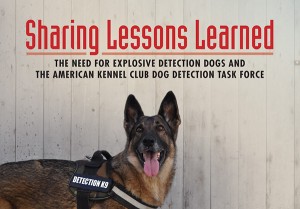Sharing Lessons Learned The Need for Explosive Detection Dogs and The American Kennel Club Dog Detection Task Force
Click here to read the complete article
110 – June, 2020
BACKGROUND
The worldwide need for explosive detection and parole dogs continues to grow despite the fact that there are more than 80 million dog owners in the US. The shortage quickly followed the events of 9/11, Brussels, Boston, Las Vegas, New York and London. According to government sources, the U.S. has historically been buying about 90 percent of its detection and patrol dogs from European breeders. Other countries have also relied on these European breeders for the same dogs, and European vendors have become the middleman who brings dogs to several locations for the convenience of the buyers. Most of the dogs are sold without pedigrees because most buyers have no interest in breeding. This system works, but not without some fault. There are issues involving the quality of the dogs, the cost and time required to train them and the fact that only about 35% of those purchased successfully complete their training and ultimately become working dogs (3). Guide dogs have a somewhat better success rate at about 50% (4).
An alternative to using dogs for detecting bombs, drugs and other illegal items is to rely on equipment. Several attempts have been made, but when put to the test, the canine was the preferred choice because, unlike equipment, the canine remains alert and ready to respond day or night, and in all kinds of weather and terrains. They do not need to be recalibrated when moved to new locations or when temperatures vary during storms, and they easily adapt to changing work environments.
As the threat of terrorism and natural disasters continues to increase, most experts agree that part of the solution begins with a “better dog”–one that is smarter, more trainable and less likely to fail when tested. What complicates this objective is the changing roles given to them. Work assignments have been extended from searches for firearms, drugs and explosives to a long list of items including lost people, cadavers, insects, larva and to serve as an early warning system for medical conditions (1). Purebred dogs are preferred because their size, color, traits and performance are predictable, and when coupled with their portability, loyalty, trustworthiness, work ethic, strength and speed, they make the ideal candidates for explosive detection and patrol work.
Click here to read the complete article
110 – June, 2020
Short URL: http://caninechronicle.com/?p=185008
Comments are closed












